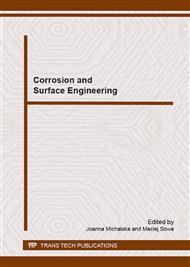p.221
p.225
p.229
p.233
p.239
p.243
p.247
p.251
p.255
Atmospheric Corrosion Protection of Metallic Structures Using Geocements-Based Coatings
Abstract:
It is known that load-bearing metallic structures that are in service in the atmospheric conditions showed that are exposed to corrosion. The known-in-the art paint-and-lacquer protective coatings can provide protection of metal surfaces for a rather short period between 5 to 10 years. That is why these structures should be protected by the more advanced coatings of new generation, namely: geocement-based coatings which differ from the known-in-the-art binding materials by formation in the hydration products of the zeolite-like minerals and feldspathoids. The paper discusses substantiation of choice of geocement composition in the (хК, уna)2O⋅Al2O3⋅nSiO2⋅mH2O system, target synthesis of hydration products of the geocements matrix in the fields of dynamic cavitation, optimal parameters of cavitation treatment aimed at nanostructurization of the geocements matrix in order to synthesize zeolite-like and hydromicaceous phases, choice of appropriate hardening agents and fillers etc. for producing highly efficient protective coatings with high corrosion resistance, high adhesion to metallic substrate and durability.
Info:
Periodical:
Pages:
239-242
Citation:
Online since:
January 2015
Price:
Сopyright:
© 2015 Trans Tech Publications Ltd. All Rights Reserved
Share:
Citation:


